Analysis of Renewable Energy Integration in TRNC Power Systems
VerifiedAdded on 2022/08/26
|8
|3446
|18
Report
AI Summary
This report investigates the integration of renewable energy sources, specifically focusing on the Turkish Republic of Northern Cyprus (TRNC). The paper begins with an abstract highlighting the global trend towards energy efficiency and reduced carbon emissions, particularly in the context of the EU's 2050 renewable energy goals. The introduction discusses the shift from non-renewable to renewable energy sources, emphasizing the importance of sustainability and efficiency. It reviews the global investment trends in renewable energy, especially solar and wind power, and explores the challenges and opportunities in integrating these sources into existing power systems. The literature review covers the integration of renewable sources into the grid, discussing the need for grid flexibility, cost considerations, and the importance of government incentives and new transmission infrastructure. A case study of TRNC is presented, analyzing its current energy situation, which heavily relies on imported oil, and its potential for solar, wind, and biogas energy. The report examines TRNC's solar irradiation potential and wind power capacity, discussing the actions needed to achieve a 100% renewable energy transition by 2050, including the integration of solar PV, concentrated solar power, and biogas with the existing grid. The report also includes tables and figures from the assignment brief to further support the analysis.
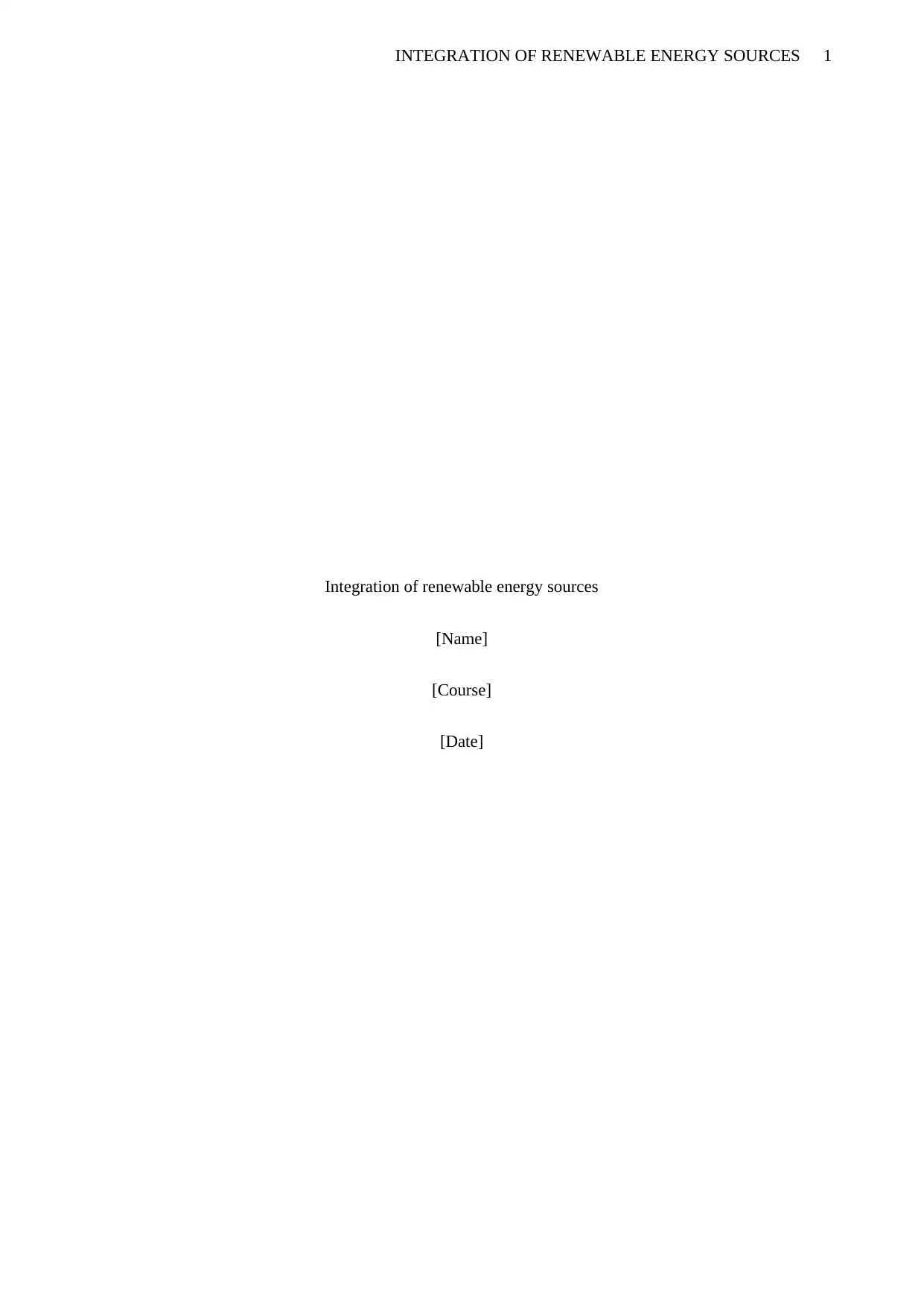
1INTEGRATION OF RENEWABLE ENERGY SOURCES
Integration of renewable energy sources
[Name]
[Course]
[Date]
Integration of renewable energy sources
[Name]
[Course]
[Date]
Paraphrase This Document
Need a fresh take? Get an instant paraphrase of this document with our AI Paraphraser
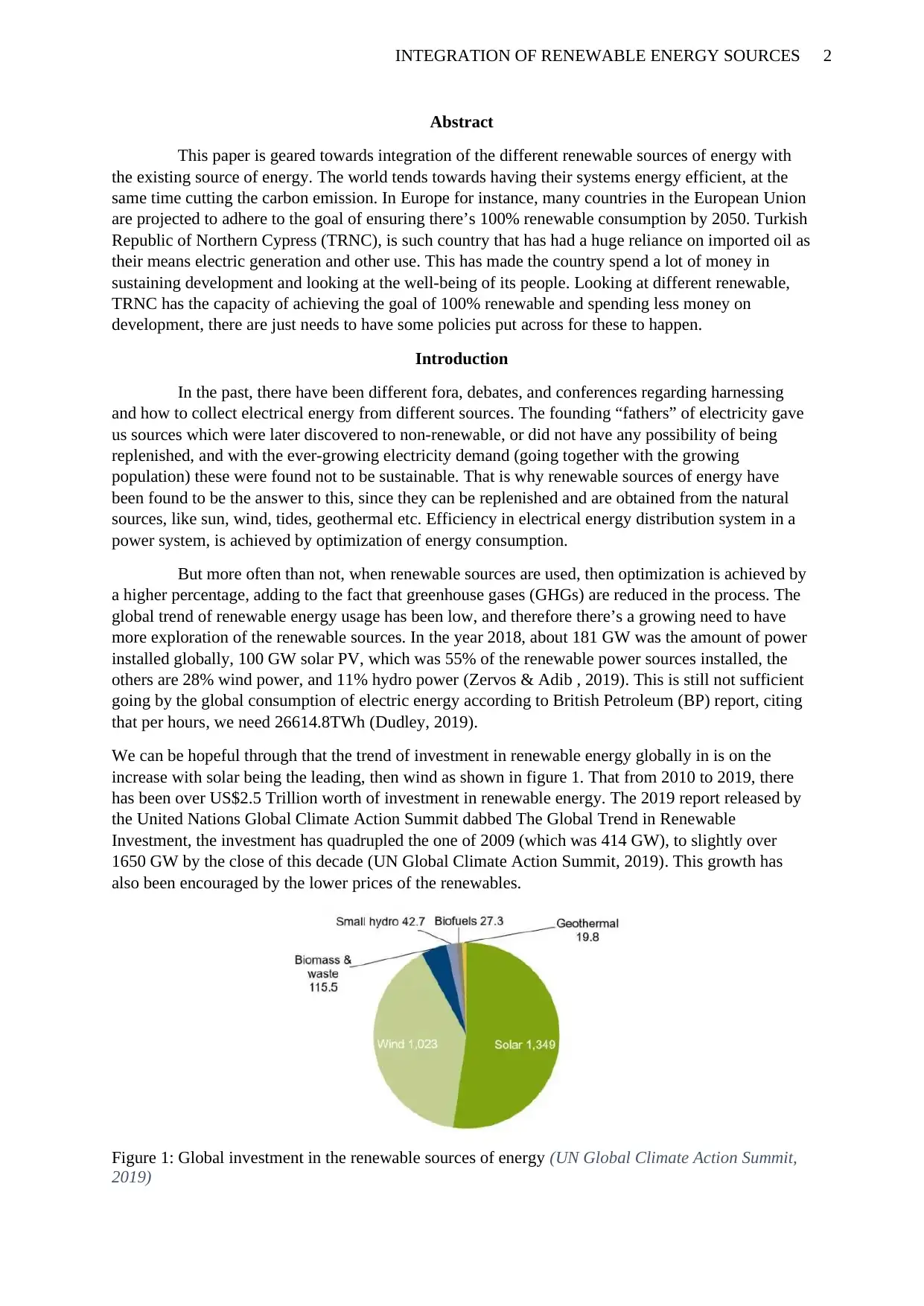
2INTEGRATION OF RENEWABLE ENERGY SOURCES
Abstract
This paper is geared towards integration of the different renewable sources of energy with
the existing source of energy. The world tends towards having their systems energy efficient, at the
same time cutting the carbon emission. In Europe for instance, many countries in the European Union
are projected to adhere to the goal of ensuring there’s 100% renewable consumption by 2050. Turkish
Republic of Northern Cypress (TRNC), is such country that has had a huge reliance on imported oil as
their means electric generation and other use. This has made the country spend a lot of money in
sustaining development and looking at the well-being of its people. Looking at different renewable,
TRNC has the capacity of achieving the goal of 100% renewable and spending less money on
development, there are just needs to have some policies put across for these to happen.
Introduction
In the past, there have been different fora, debates, and conferences regarding harnessing
and how to collect electrical energy from different sources. The founding “fathers” of electricity gave
us sources which were later discovered to non-renewable, or did not have any possibility of being
replenished, and with the ever-growing electricity demand (going together with the growing
population) these were found not to be sustainable. That is why renewable sources of energy have
been found to be the answer to this, since they can be replenished and are obtained from the natural
sources, like sun, wind, tides, geothermal etc. Efficiency in electrical energy distribution system in a
power system, is achieved by optimization of energy consumption.
But more often than not, when renewable sources are used, then optimization is achieved by
a higher percentage, adding to the fact that greenhouse gases (GHGs) are reduced in the process. The
global trend of renewable energy usage has been low, and therefore there’s a growing need to have
more exploration of the renewable sources. In the year 2018, about 181 GW was the amount of power
installed globally, 100 GW solar PV, which was 55% of the renewable power sources installed, the
others are 28% wind power, and 11% hydro power (Zervos & Adib , 2019). This is still not sufficient
going by the global consumption of electric energy according to British Petroleum (BP) report, citing
that per hours, we need 26614.8TWh (Dudley, 2019).
We can be hopeful through that the trend of investment in renewable energy globally in is on the
increase with solar being the leading, then wind as shown in figure 1. That from 2010 to 2019, there
has been over US$2.5 Trillion worth of investment in renewable energy. The 2019 report released by
the United Nations Global Climate Action Summit dabbed The Global Trend in Renewable
Investment, the investment has quadrupled the one of 2009 (which was 414 GW), to slightly over
1650 GW by the close of this decade (UN Global Climate Action Summit, 2019). This growth has
also been encouraged by the lower prices of the renewables.
Figure 1: Global investment in the renewable sources of energy (UN Global Climate Action Summit,
2019)
Abstract
This paper is geared towards integration of the different renewable sources of energy with
the existing source of energy. The world tends towards having their systems energy efficient, at the
same time cutting the carbon emission. In Europe for instance, many countries in the European Union
are projected to adhere to the goal of ensuring there’s 100% renewable consumption by 2050. Turkish
Republic of Northern Cypress (TRNC), is such country that has had a huge reliance on imported oil as
their means electric generation and other use. This has made the country spend a lot of money in
sustaining development and looking at the well-being of its people. Looking at different renewable,
TRNC has the capacity of achieving the goal of 100% renewable and spending less money on
development, there are just needs to have some policies put across for these to happen.
Introduction
In the past, there have been different fora, debates, and conferences regarding harnessing
and how to collect electrical energy from different sources. The founding “fathers” of electricity gave
us sources which were later discovered to non-renewable, or did not have any possibility of being
replenished, and with the ever-growing electricity demand (going together with the growing
population) these were found not to be sustainable. That is why renewable sources of energy have
been found to be the answer to this, since they can be replenished and are obtained from the natural
sources, like sun, wind, tides, geothermal etc. Efficiency in electrical energy distribution system in a
power system, is achieved by optimization of energy consumption.
But more often than not, when renewable sources are used, then optimization is achieved by
a higher percentage, adding to the fact that greenhouse gases (GHGs) are reduced in the process. The
global trend of renewable energy usage has been low, and therefore there’s a growing need to have
more exploration of the renewable sources. In the year 2018, about 181 GW was the amount of power
installed globally, 100 GW solar PV, which was 55% of the renewable power sources installed, the
others are 28% wind power, and 11% hydro power (Zervos & Adib , 2019). This is still not sufficient
going by the global consumption of electric energy according to British Petroleum (BP) report, citing
that per hours, we need 26614.8TWh (Dudley, 2019).
We can be hopeful through that the trend of investment in renewable energy globally in is on the
increase with solar being the leading, then wind as shown in figure 1. That from 2010 to 2019, there
has been over US$2.5 Trillion worth of investment in renewable energy. The 2019 report released by
the United Nations Global Climate Action Summit dabbed The Global Trend in Renewable
Investment, the investment has quadrupled the one of 2009 (which was 414 GW), to slightly over
1650 GW by the close of this decade (UN Global Climate Action Summit, 2019). This growth has
also been encouraged by the lower prices of the renewables.
Figure 1: Global investment in the renewable sources of energy (UN Global Climate Action Summit,
2019)
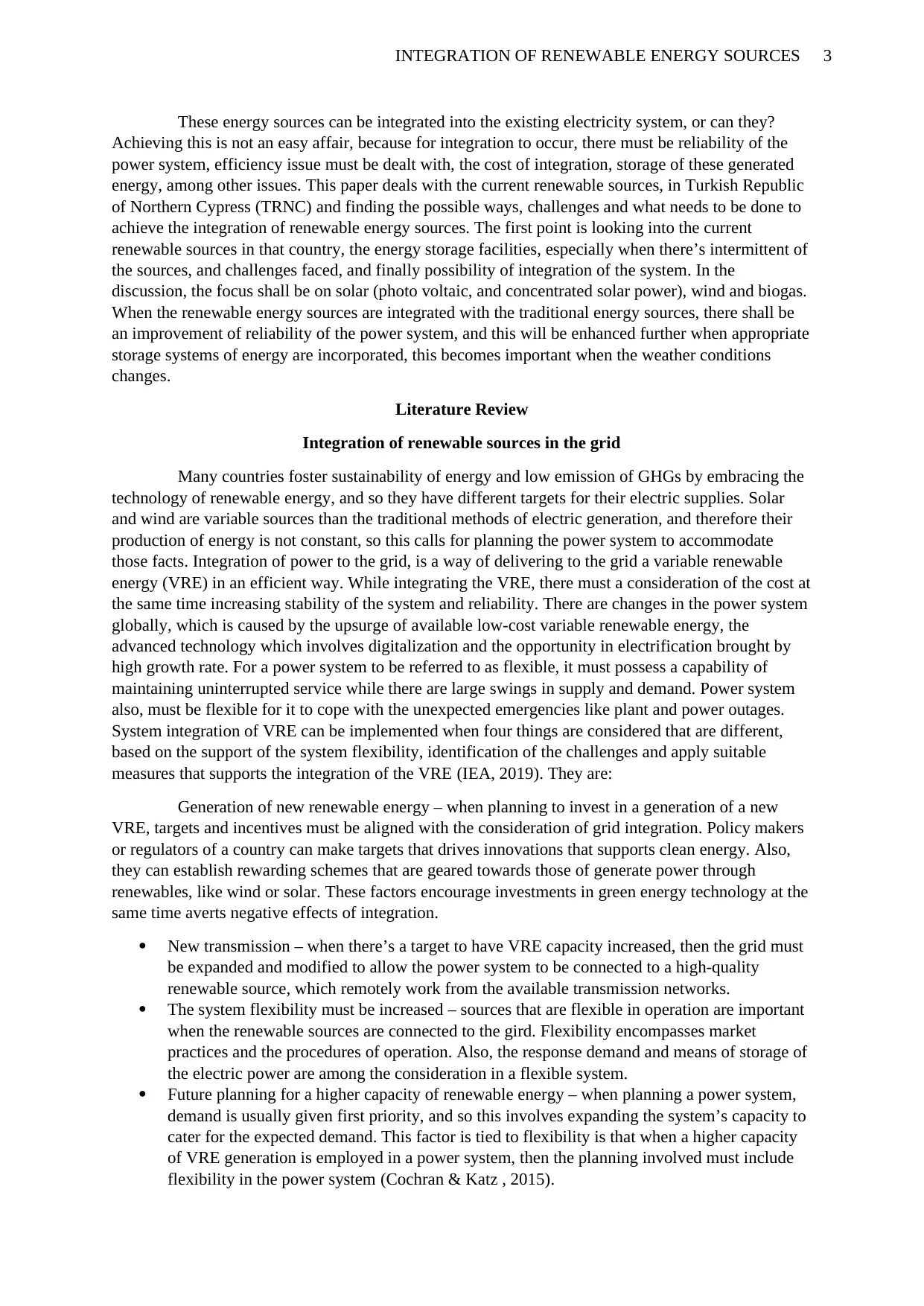
3INTEGRATION OF RENEWABLE ENERGY SOURCES
These energy sources can be integrated into the existing electricity system, or can they?
Achieving this is not an easy affair, because for integration to occur, there must be reliability of the
power system, efficiency issue must be dealt with, the cost of integration, storage of these generated
energy, among other issues. This paper deals with the current renewable sources, in Turkish Republic
of Northern Cypress (TRNC) and finding the possible ways, challenges and what needs to be done to
achieve the integration of renewable energy sources. The first point is looking into the current
renewable sources in that country, the energy storage facilities, especially when there’s intermittent of
the sources, and challenges faced, and finally possibility of integration of the system. In the
discussion, the focus shall be on solar (photo voltaic, and concentrated solar power), wind and biogas.
When the renewable energy sources are integrated with the traditional energy sources, there shall be
an improvement of reliability of the power system, and this will be enhanced further when appropriate
storage systems of energy are incorporated, this becomes important when the weather conditions
changes.
Literature Review
Integration of renewable sources in the grid
Many countries foster sustainability of energy and low emission of GHGs by embracing the
technology of renewable energy, and so they have different targets for their electric supplies. Solar
and wind are variable sources than the traditional methods of electric generation, and therefore their
production of energy is not constant, so this calls for planning the power system to accommodate
those facts. Integration of power to the grid, is a way of delivering to the grid a variable renewable
energy (VRE) in an efficient way. While integrating the VRE, there must a consideration of the cost at
the same time increasing stability of the system and reliability. There are changes in the power system
globally, which is caused by the upsurge of available low-cost variable renewable energy, the
advanced technology which involves digitalization and the opportunity in electrification brought by
high growth rate. For a power system to be referred to as flexible, it must possess a capability of
maintaining uninterrupted service while there are large swings in supply and demand. Power system
also, must be flexible for it to cope with the unexpected emergencies like plant and power outages.
System integration of VRE can be implemented when four things are considered that are different,
based on the support of the system flexibility, identification of the challenges and apply suitable
measures that supports the integration of the VRE (IEA, 2019). They are:
Generation of new renewable energy – when planning to invest in a generation of a new
VRE, targets and incentives must be aligned with the consideration of grid integration. Policy makers
or regulators of a country can make targets that drives innovations that supports clean energy. Also,
they can establish rewarding schemes that are geared towards those of generate power through
renewables, like wind or solar. These factors encourage investments in green energy technology at the
same time averts negative effects of integration.
New transmission – when there’s a target to have VRE capacity increased, then the grid must
be expanded and modified to allow the power system to be connected to a high-quality
renewable source, which remotely work from the available transmission networks.
The system flexibility must be increased – sources that are flexible in operation are important
when the renewable sources are connected to the gird. Flexibility encompasses market
practices and the procedures of operation. Also, the response demand and means of storage of
the electric power are among the consideration in a flexible system.
Future planning for a higher capacity of renewable energy – when planning a power system,
demand is usually given first priority, and so this involves expanding the system’s capacity to
cater for the expected demand. This factor is tied to flexibility is that when a higher capacity
of VRE generation is employed in a power system, then the planning involved must include
flexibility in the power system (Cochran & Katz , 2015).
These energy sources can be integrated into the existing electricity system, or can they?
Achieving this is not an easy affair, because for integration to occur, there must be reliability of the
power system, efficiency issue must be dealt with, the cost of integration, storage of these generated
energy, among other issues. This paper deals with the current renewable sources, in Turkish Republic
of Northern Cypress (TRNC) and finding the possible ways, challenges and what needs to be done to
achieve the integration of renewable energy sources. The first point is looking into the current
renewable sources in that country, the energy storage facilities, especially when there’s intermittent of
the sources, and challenges faced, and finally possibility of integration of the system. In the
discussion, the focus shall be on solar (photo voltaic, and concentrated solar power), wind and biogas.
When the renewable energy sources are integrated with the traditional energy sources, there shall be
an improvement of reliability of the power system, and this will be enhanced further when appropriate
storage systems of energy are incorporated, this becomes important when the weather conditions
changes.
Literature Review
Integration of renewable sources in the grid
Many countries foster sustainability of energy and low emission of GHGs by embracing the
technology of renewable energy, and so they have different targets for their electric supplies. Solar
and wind are variable sources than the traditional methods of electric generation, and therefore their
production of energy is not constant, so this calls for planning the power system to accommodate
those facts. Integration of power to the grid, is a way of delivering to the grid a variable renewable
energy (VRE) in an efficient way. While integrating the VRE, there must a consideration of the cost at
the same time increasing stability of the system and reliability. There are changes in the power system
globally, which is caused by the upsurge of available low-cost variable renewable energy, the
advanced technology which involves digitalization and the opportunity in electrification brought by
high growth rate. For a power system to be referred to as flexible, it must possess a capability of
maintaining uninterrupted service while there are large swings in supply and demand. Power system
also, must be flexible for it to cope with the unexpected emergencies like plant and power outages.
System integration of VRE can be implemented when four things are considered that are different,
based on the support of the system flexibility, identification of the challenges and apply suitable
measures that supports the integration of the VRE (IEA, 2019). They are:
Generation of new renewable energy – when planning to invest in a generation of a new
VRE, targets and incentives must be aligned with the consideration of grid integration. Policy makers
or regulators of a country can make targets that drives innovations that supports clean energy. Also,
they can establish rewarding schemes that are geared towards those of generate power through
renewables, like wind or solar. These factors encourage investments in green energy technology at the
same time averts negative effects of integration.
New transmission – when there’s a target to have VRE capacity increased, then the grid must
be expanded and modified to allow the power system to be connected to a high-quality
renewable source, which remotely work from the available transmission networks.
The system flexibility must be increased – sources that are flexible in operation are important
when the renewable sources are connected to the gird. Flexibility encompasses market
practices and the procedures of operation. Also, the response demand and means of storage of
the electric power are among the consideration in a flexible system.
Future planning for a higher capacity of renewable energy – when planning a power system,
demand is usually given first priority, and so this involves expanding the system’s capacity to
cater for the expected demand. This factor is tied to flexibility is that when a higher capacity
of VRE generation is employed in a power system, then the planning involved must include
flexibility in the power system (Cochran & Katz , 2015).
⊘ This is a preview!⊘
Do you want full access?
Subscribe today to unlock all pages.

Trusted by 1+ million students worldwide
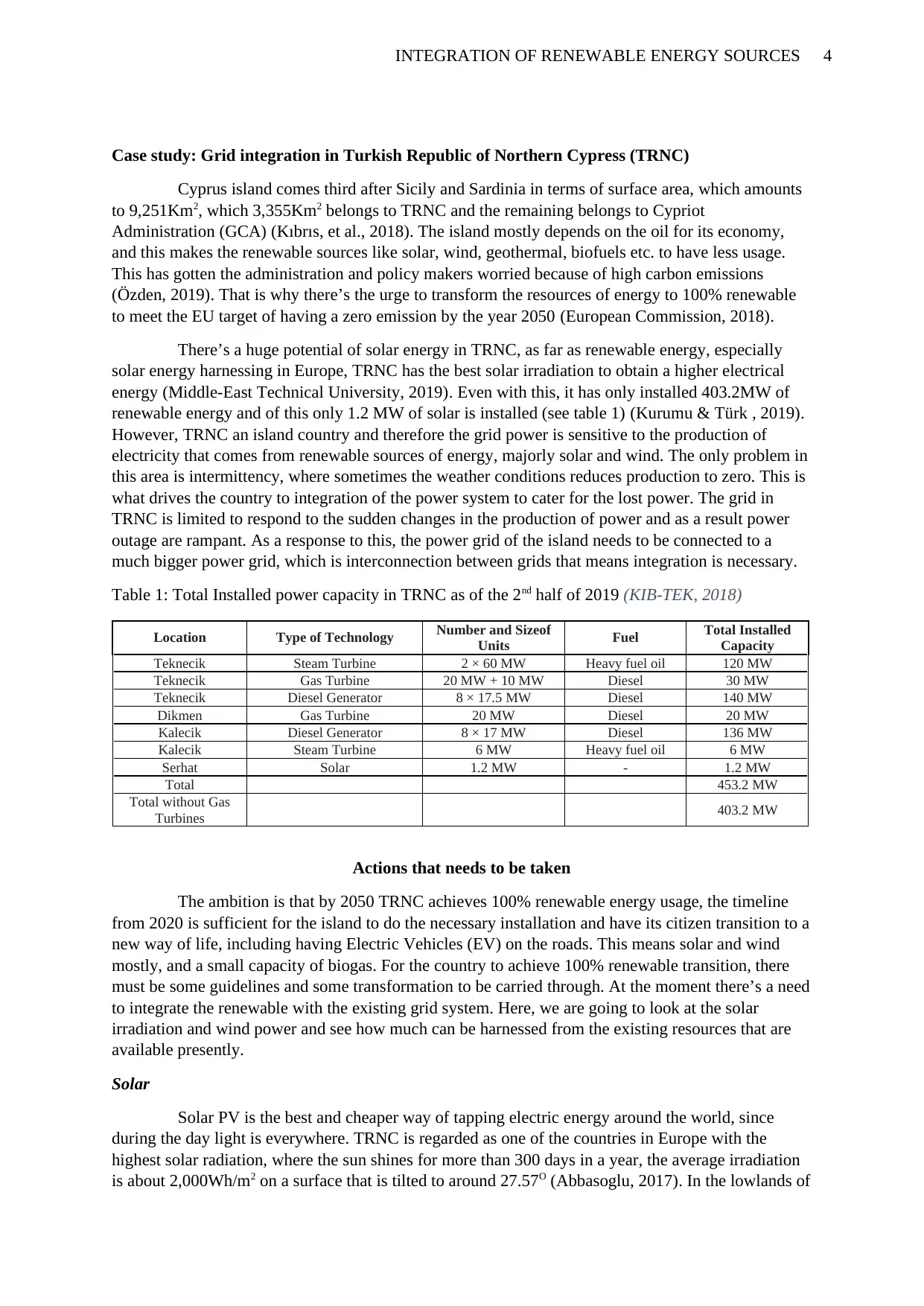
4INTEGRATION OF RENEWABLE ENERGY SOURCES
Case study: Grid integration in Turkish Republic of Northern Cypress (TRNC)
Cyprus island comes third after Sicily and Sardinia in terms of surface area, which amounts
to 9,251Km2, which 3,355Km2 belongs to TRNC and the remaining belongs to Cypriot
Administration (GCA) (Kıbrıs, et al., 2018). The island mostly depends on the oil for its economy,
and this makes the renewable sources like solar, wind, geothermal, biofuels etc. to have less usage.
This has gotten the administration and policy makers worried because of high carbon emissions
(Özden, 2019). That is why there’s the urge to transform the resources of energy to 100% renewable
to meet the EU target of having a zero emission by the year 2050 (European Commission, 2018).
There’s a huge potential of solar energy in TRNC, as far as renewable energy, especially
solar energy harnessing in Europe, TRNC has the best solar irradiation to obtain a higher electrical
energy (Middle-East Technical University, 2019). Even with this, it has only installed 403.2MW of
renewable energy and of this only 1.2 MW of solar is installed (see table 1) (Kurumu & Türk , 2019).
However, TRNC an island country and therefore the grid power is sensitive to the production of
electricity that comes from renewable sources of energy, majorly solar and wind. The only problem in
this area is intermittency, where sometimes the weather conditions reduces production to zero. This is
what drives the country to integration of the power system to cater for the lost power. The grid in
TRNC is limited to respond to the sudden changes in the production of power and as a result power
outage are rampant. As a response to this, the power grid of the island needs to be connected to a
much bigger power grid, which is interconnection between grids that means integration is necessary.
Table 1: Total Installed power capacity in TRNC as of the 2nd half of 2019 (KIB-TEK, 2018)
Location Type of Technology Number and Sizeof
Units Fuel Total Installed
Capacity
Teknecik Steam Turbine 2 × 60 MW Heavy fuel oil 120 MW
Teknecik Gas Turbine 20 MW + 10 MW Diesel 30 MW
Teknecik Diesel Generator 8 × 17.5 MW Diesel 140 MW
Dikmen Gas Turbine 20 MW Diesel 20 MW
Kalecik Diesel Generator 8 × 17 MW Diesel 136 MW
Kalecik Steam Turbine 6 MW Heavy fuel oil 6 MW
Serhat Solar 1.2 MW - 1.2 MW
Total 453.2 MW
Total without Gas
Turbines 403.2 MW
Actions that needs to be taken
The ambition is that by 2050 TRNC achieves 100% renewable energy usage, the timeline
from 2020 is sufficient for the island to do the necessary installation and have its citizen transition to a
new way of life, including having Electric Vehicles (EV) on the roads. This means solar and wind
mostly, and a small capacity of biogas. For the country to achieve 100% renewable transition, there
must be some guidelines and some transformation to be carried through. At the moment there’s a need
to integrate the renewable with the existing grid system. Here, we are going to look at the solar
irradiation and wind power and see how much can be harnessed from the existing resources that are
available presently.
Solar
Solar PV is the best and cheaper way of tapping electric energy around the world, since
during the day light is everywhere. TRNC is regarded as one of the countries in Europe with the
highest solar radiation, where the sun shines for more than 300 days in a year, the average irradiation
is about 2,000Wh/m2 on a surface that is tilted to around 27.57O (Abbasoglu, 2017). In the lowlands of
Case study: Grid integration in Turkish Republic of Northern Cypress (TRNC)
Cyprus island comes third after Sicily and Sardinia in terms of surface area, which amounts
to 9,251Km2, which 3,355Km2 belongs to TRNC and the remaining belongs to Cypriot
Administration (GCA) (Kıbrıs, et al., 2018). The island mostly depends on the oil for its economy,
and this makes the renewable sources like solar, wind, geothermal, biofuels etc. to have less usage.
This has gotten the administration and policy makers worried because of high carbon emissions
(Özden, 2019). That is why there’s the urge to transform the resources of energy to 100% renewable
to meet the EU target of having a zero emission by the year 2050 (European Commission, 2018).
There’s a huge potential of solar energy in TRNC, as far as renewable energy, especially
solar energy harnessing in Europe, TRNC has the best solar irradiation to obtain a higher electrical
energy (Middle-East Technical University, 2019). Even with this, it has only installed 403.2MW of
renewable energy and of this only 1.2 MW of solar is installed (see table 1) (Kurumu & Türk , 2019).
However, TRNC an island country and therefore the grid power is sensitive to the production of
electricity that comes from renewable sources of energy, majorly solar and wind. The only problem in
this area is intermittency, where sometimes the weather conditions reduces production to zero. This is
what drives the country to integration of the power system to cater for the lost power. The grid in
TRNC is limited to respond to the sudden changes in the production of power and as a result power
outage are rampant. As a response to this, the power grid of the island needs to be connected to a
much bigger power grid, which is interconnection between grids that means integration is necessary.
Table 1: Total Installed power capacity in TRNC as of the 2nd half of 2019 (KIB-TEK, 2018)
Location Type of Technology Number and Sizeof
Units Fuel Total Installed
Capacity
Teknecik Steam Turbine 2 × 60 MW Heavy fuel oil 120 MW
Teknecik Gas Turbine 20 MW + 10 MW Diesel 30 MW
Teknecik Diesel Generator 8 × 17.5 MW Diesel 140 MW
Dikmen Gas Turbine 20 MW Diesel 20 MW
Kalecik Diesel Generator 8 × 17 MW Diesel 136 MW
Kalecik Steam Turbine 6 MW Heavy fuel oil 6 MW
Serhat Solar 1.2 MW - 1.2 MW
Total 453.2 MW
Total without Gas
Turbines 403.2 MW
Actions that needs to be taken
The ambition is that by 2050 TRNC achieves 100% renewable energy usage, the timeline
from 2020 is sufficient for the island to do the necessary installation and have its citizen transition to a
new way of life, including having Electric Vehicles (EV) on the roads. This means solar and wind
mostly, and a small capacity of biogas. For the country to achieve 100% renewable transition, there
must be some guidelines and some transformation to be carried through. At the moment there’s a need
to integrate the renewable with the existing grid system. Here, we are going to look at the solar
irradiation and wind power and see how much can be harnessed from the existing resources that are
available presently.
Solar
Solar PV is the best and cheaper way of tapping electric energy around the world, since
during the day light is everywhere. TRNC is regarded as one of the countries in Europe with the
highest solar radiation, where the sun shines for more than 300 days in a year, the average irradiation
is about 2,000Wh/m2 on a surface that is tilted to around 27.57O (Abbasoglu, 2017). In the lowlands of
Paraphrase This Document
Need a fresh take? Get an instant paraphrase of this document with our AI Paraphraser
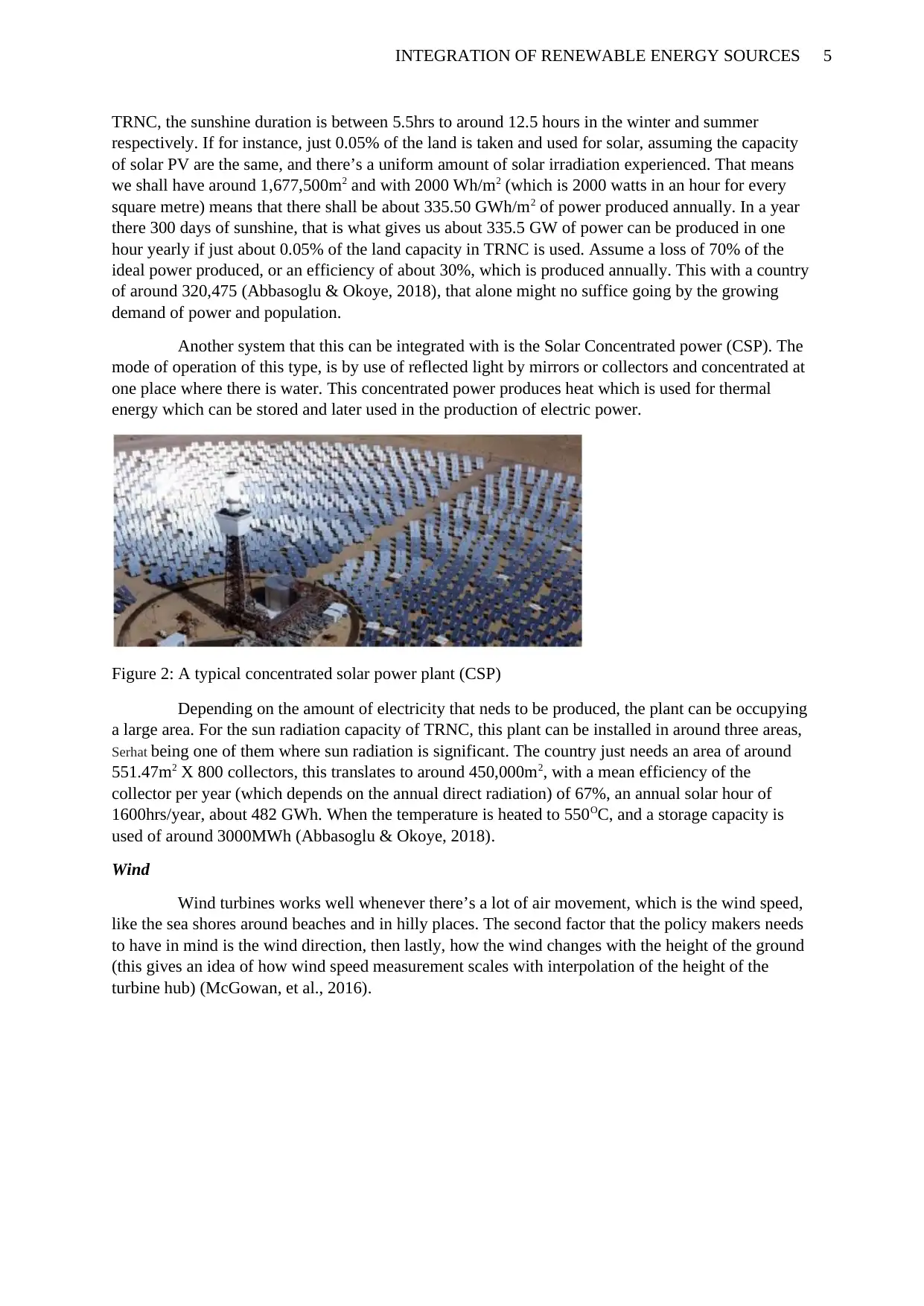
5INTEGRATION OF RENEWABLE ENERGY SOURCES
TRNC, the sunshine duration is between 5.5hrs to around 12.5 hours in the winter and summer
respectively. If for instance, just 0.05% of the land is taken and used for solar, assuming the capacity
of solar PV are the same, and there’s a uniform amount of solar irradiation experienced. That means
we shall have around 1,677,500m2 and with 2000 Wh/m2 (which is 2000 watts in an hour for every
square metre) means that there shall be about 335.50 GWh/m2 of power produced annually. In a year
there 300 days of sunshine, that is what gives us about 335.5 GW of power can be produced in one
hour yearly if just about 0.05% of the land capacity in TRNC is used. Assume a loss of 70% of the
ideal power produced, or an efficiency of about 30%, which is produced annually. This with a country
of around 320,475 (Abbasoglu & Okoye, 2018), that alone might no suffice going by the growing
demand of power and population.
Another system that this can be integrated with is the Solar Concentrated power (CSP). The
mode of operation of this type, is by use of reflected light by mirrors or collectors and concentrated at
one place where there is water. This concentrated power produces heat which is used for thermal
energy which can be stored and later used in the production of electric power.
Figure 2: A typical concentrated solar power plant (CSP)
Depending on the amount of electricity that neds to be produced, the plant can be occupying
a large area. For the sun radiation capacity of TRNC, this plant can be installed in around three areas,
Serhat being one of them where sun radiation is significant. The country just needs an area of around
551.47m2 X 800 collectors, this translates to around 450,000m2, with a mean efficiency of the
collector per year (which depends on the annual direct radiation) of 67%, an annual solar hour of
1600hrs/year, about 482 GWh. When the temperature is heated to 550OC, and a storage capacity is
used of around 3000MWh (Abbasoglu & Okoye, 2018).
Wind
Wind turbines works well whenever there’s a lot of air movement, which is the wind speed,
like the sea shores around beaches and in hilly places. The second factor that the policy makers needs
to have in mind is the wind direction, then lastly, how the wind changes with the height of the ground
(this gives an idea of how wind speed measurement scales with interpolation of the height of the
turbine hub) (McGowan, et al., 2016).
TRNC, the sunshine duration is between 5.5hrs to around 12.5 hours in the winter and summer
respectively. If for instance, just 0.05% of the land is taken and used for solar, assuming the capacity
of solar PV are the same, and there’s a uniform amount of solar irradiation experienced. That means
we shall have around 1,677,500m2 and with 2000 Wh/m2 (which is 2000 watts in an hour for every
square metre) means that there shall be about 335.50 GWh/m2 of power produced annually. In a year
there 300 days of sunshine, that is what gives us about 335.5 GW of power can be produced in one
hour yearly if just about 0.05% of the land capacity in TRNC is used. Assume a loss of 70% of the
ideal power produced, or an efficiency of about 30%, which is produced annually. This with a country
of around 320,475 (Abbasoglu & Okoye, 2018), that alone might no suffice going by the growing
demand of power and population.
Another system that this can be integrated with is the Solar Concentrated power (CSP). The
mode of operation of this type, is by use of reflected light by mirrors or collectors and concentrated at
one place where there is water. This concentrated power produces heat which is used for thermal
energy which can be stored and later used in the production of electric power.
Figure 2: A typical concentrated solar power plant (CSP)
Depending on the amount of electricity that neds to be produced, the plant can be occupying
a large area. For the sun radiation capacity of TRNC, this plant can be installed in around three areas,
Serhat being one of them where sun radiation is significant. The country just needs an area of around
551.47m2 X 800 collectors, this translates to around 450,000m2, with a mean efficiency of the
collector per year (which depends on the annual direct radiation) of 67%, an annual solar hour of
1600hrs/year, about 482 GWh. When the temperature is heated to 550OC, and a storage capacity is
used of around 3000MWh (Abbasoglu & Okoye, 2018).
Wind
Wind turbines works well whenever there’s a lot of air movement, which is the wind speed,
like the sea shores around beaches and in hilly places. The second factor that the policy makers needs
to have in mind is the wind direction, then lastly, how the wind changes with the height of the ground
(this gives an idea of how wind speed measurement scales with interpolation of the height of the
turbine hub) (McGowan, et al., 2016).
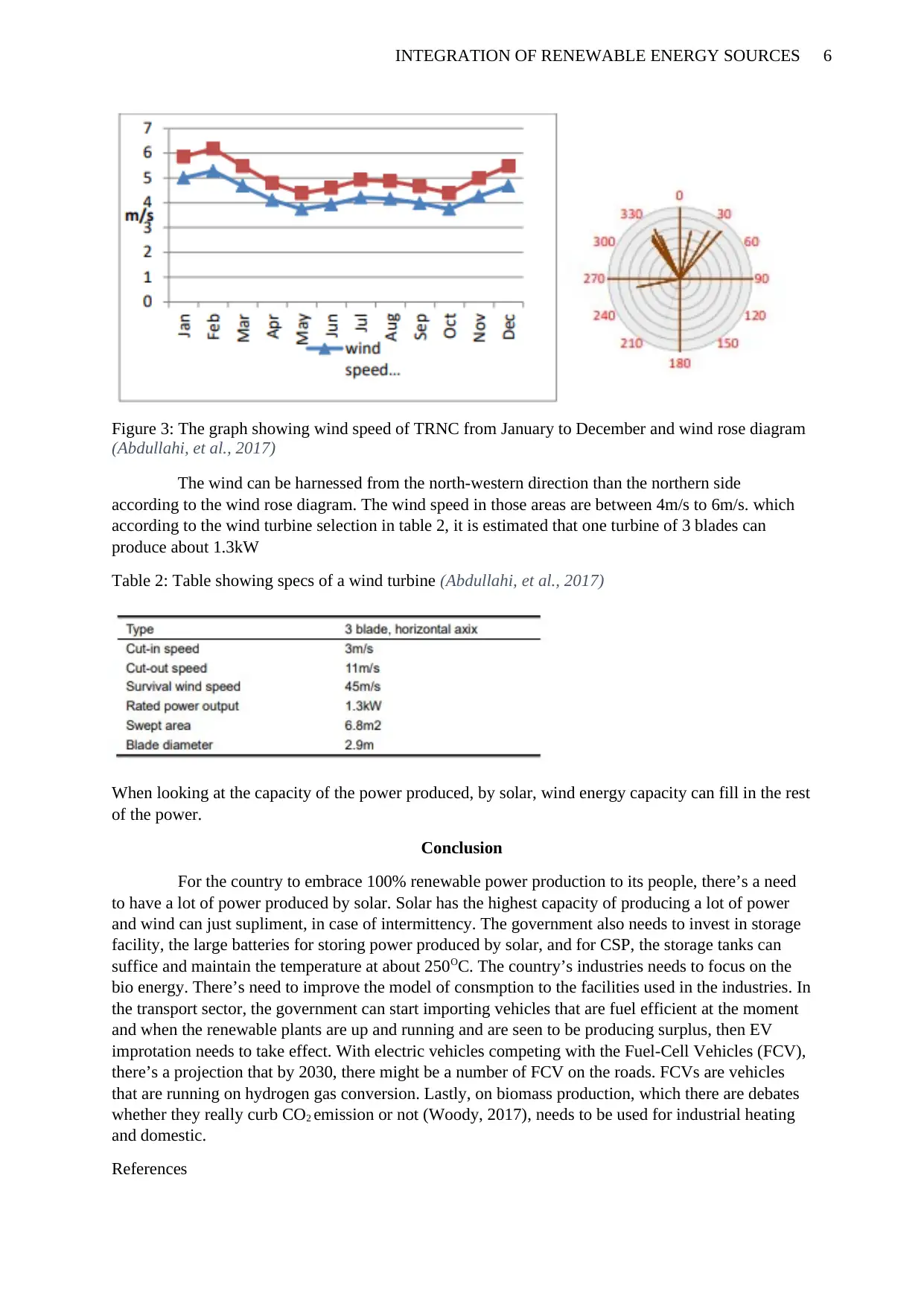
6INTEGRATION OF RENEWABLE ENERGY SOURCES
Figure 3: The graph showing wind speed of TRNC from January to December and wind rose diagram
(Abdullahi, et al., 2017)
The wind can be harnessed from the north-western direction than the northern side
according to the wind rose diagram. The wind speed in those areas are between 4m/s to 6m/s. which
according to the wind turbine selection in table 2, it is estimated that one turbine of 3 blades can
produce about 1.3kW
Table 2: Table showing specs of a wind turbine (Abdullahi, et al., 2017)
When looking at the capacity of the power produced, by solar, wind energy capacity can fill in the rest
of the power.
Conclusion
For the country to embrace 100% renewable power production to its people, there’s a need
to have a lot of power produced by solar. Solar has the highest capacity of producing a lot of power
and wind can just supliment, in case of intermittency. The government also needs to invest in storage
facility, the large batteries for storing power produced by solar, and for CSP, the storage tanks can
suffice and maintain the temperature at about 250OC. The country’s industries needs to focus on the
bio energy. There’s need to improve the model of consmption to the facilities used in the industries. In
the transport sector, the government can start importing vehicles that are fuel efficient at the moment
and when the renewable plants are up and running and are seen to be producing surplus, then EV
improtation needs to take effect. With electric vehicles competing with the Fuel-Cell Vehicles (FCV),
there’s a projection that by 2030, there might be a number of FCV on the roads. FCVs are vehicles
that are running on hydrogen gas conversion. Lastly, on biomass production, which there are debates
whether they really curb CO2 emission or not (Woody, 2017), needs to be used for industrial heating
and domestic.
References
Figure 3: The graph showing wind speed of TRNC from January to December and wind rose diagram
(Abdullahi, et al., 2017)
The wind can be harnessed from the north-western direction than the northern side
according to the wind rose diagram. The wind speed in those areas are between 4m/s to 6m/s. which
according to the wind turbine selection in table 2, it is estimated that one turbine of 3 blades can
produce about 1.3kW
Table 2: Table showing specs of a wind turbine (Abdullahi, et al., 2017)
When looking at the capacity of the power produced, by solar, wind energy capacity can fill in the rest
of the power.
Conclusion
For the country to embrace 100% renewable power production to its people, there’s a need
to have a lot of power produced by solar. Solar has the highest capacity of producing a lot of power
and wind can just supliment, in case of intermittency. The government also needs to invest in storage
facility, the large batteries for storing power produced by solar, and for CSP, the storage tanks can
suffice and maintain the temperature at about 250OC. The country’s industries needs to focus on the
bio energy. There’s need to improve the model of consmption to the facilities used in the industries. In
the transport sector, the government can start importing vehicles that are fuel efficient at the moment
and when the renewable plants are up and running and are seen to be producing surplus, then EV
improtation needs to take effect. With electric vehicles competing with the Fuel-Cell Vehicles (FCV),
there’s a projection that by 2030, there might be a number of FCV on the roads. FCVs are vehicles
that are running on hydrogen gas conversion. Lastly, on biomass production, which there are debates
whether they really curb CO2 emission or not (Woody, 2017), needs to be used for industrial heating
and domestic.
References
⊘ This is a preview!⊘
Do you want full access?
Subscribe today to unlock all pages.

Trusted by 1+ million students worldwide
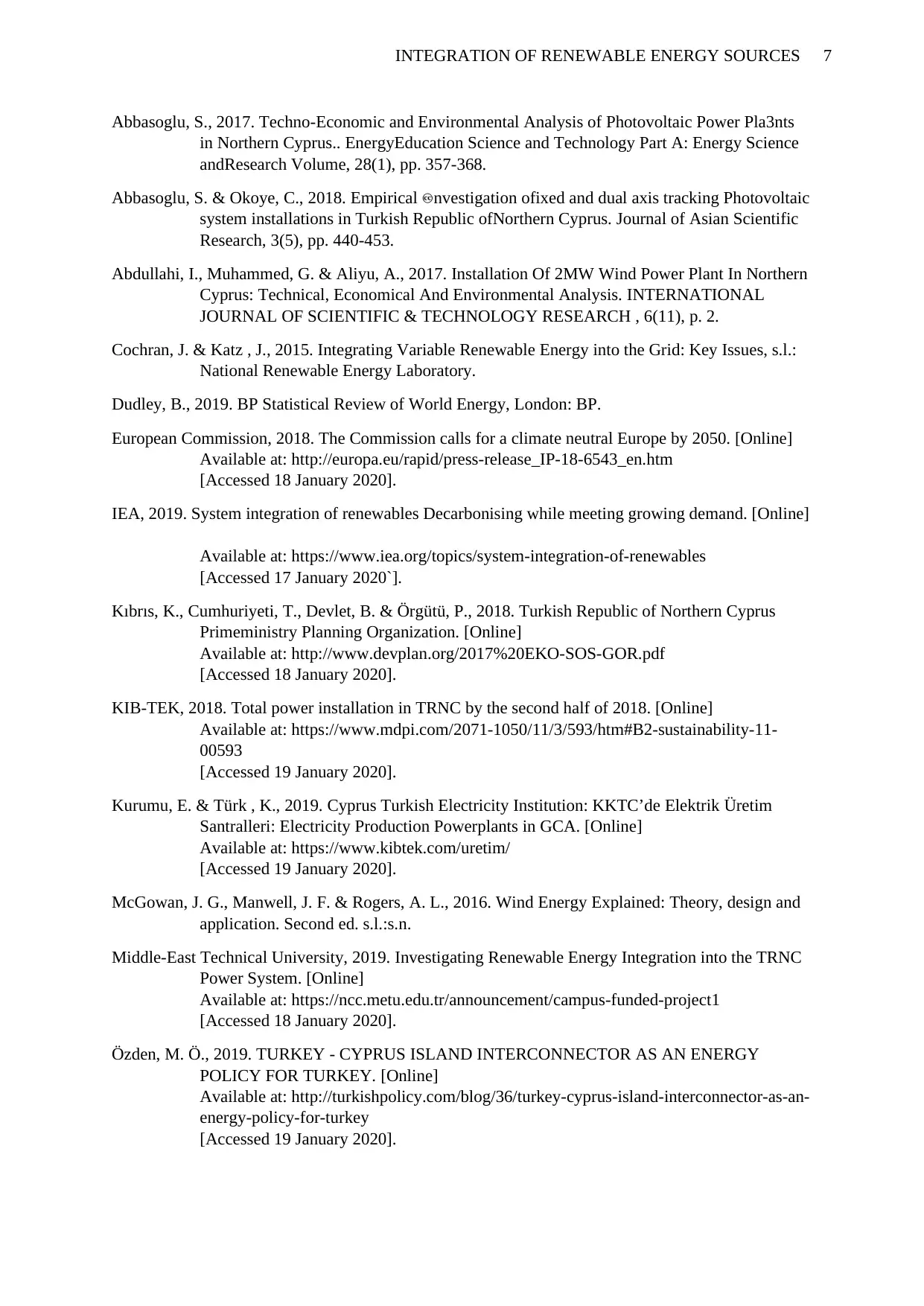
7INTEGRATION OF RENEWABLE ENERGY SOURCES
Abbasoglu, S., 2017. Techno-Economic and Environmental Analysis of Photovoltaic Power Pla3nts
in Northern Cyprus.. EnergyEducation Science and Technology Part A: Energy Science
andResearch Volume, 28(1), pp. 357-368.
Abbasoglu, S. & Okoye, C., 2018. Empirical nvestigation ofixed and dual axis tracking Photovoltaic
system installations in Turkish Republic ofNorthern Cyprus. Journal of Asian Scientific
Research, 3(5), pp. 440-453.
Abdullahi, I., Muhammed, G. & Aliyu, A., 2017. Installation Of 2MW Wind Power Plant In Northern
Cyprus: Technical, Economical And Environmental Analysis. INTERNATIONAL
JOURNAL OF SCIENTIFIC & TECHNOLOGY RESEARCH , 6(11), p. 2.
Cochran, J. & Katz , J., 2015. Integrating Variable Renewable Energy into the Grid: Key Issues, s.l.:
National Renewable Energy Laboratory.
Dudley, B., 2019. BP Statistical Review of World Energy, London: BP.
European Commission, 2018. The Commission calls for a climate neutral Europe by 2050. [Online]
Available at: http://europa.eu/rapid/press-release_IP-18-6543_en.htm
[Accessed 18 January 2020].
IEA, 2019. System integration of renewables Decarbonising while meeting growing demand. [Online]
Available at: https://www.iea.org/topics/system-integration-of-renewables
[Accessed 17 January 2020`].
Kıbrıs, K., Cumhuriyeti, T., Devlet, B. & Örgütü, P., 2018. Turkish Republic of Northern Cyprus
Primeministry Planning Organization. [Online]
Available at: http://www.devplan.org/2017%20EKO-SOS-GOR.pdf
[Accessed 18 January 2020].
KIB-TEK, 2018. Total power installation in TRNC by the second half of 2018. [Online]
Available at: https://www.mdpi.com/2071-1050/11/3/593/htm#B2-sustainability-11-
00593
[Accessed 19 January 2020].
Kurumu, E. & Türk , K., 2019. Cyprus Turkish Electricity Institution: KKTC’de Elektrik Üretim
Santralleri: Electricity Production Powerplants in GCA. [Online]
Available at: https://www.kibtek.com/uretim/
[Accessed 19 January 2020].
McGowan, J. G., Manwell, J. F. & Rogers, A. L., 2016. Wind Energy Explained: Theory, design and
application. Second ed. s.l.:s.n.
Middle-East Technical University, 2019. Investigating Renewable Energy Integration into the TRNC
Power System. [Online]
Available at: https://ncc.metu.edu.tr/announcement/campus-funded-project1
[Accessed 18 January 2020].
Özden, M. Ö., 2019. TURKEY - CYPRUS ISLAND INTERCONNECTOR AS AN ENERGY
POLICY FOR TURKEY. [Online]
Available at: http://turkishpolicy.com/blog/36/turkey-cyprus-island-interconnector-as-an-
energy-policy-for-turkey
[Accessed 19 January 2020].
Abbasoglu, S., 2017. Techno-Economic and Environmental Analysis of Photovoltaic Power Pla3nts
in Northern Cyprus.. EnergyEducation Science and Technology Part A: Energy Science
andResearch Volume, 28(1), pp. 357-368.
Abbasoglu, S. & Okoye, C., 2018. Empirical nvestigation ofixed and dual axis tracking Photovoltaic
system installations in Turkish Republic ofNorthern Cyprus. Journal of Asian Scientific
Research, 3(5), pp. 440-453.
Abdullahi, I., Muhammed, G. & Aliyu, A., 2017. Installation Of 2MW Wind Power Plant In Northern
Cyprus: Technical, Economical And Environmental Analysis. INTERNATIONAL
JOURNAL OF SCIENTIFIC & TECHNOLOGY RESEARCH , 6(11), p. 2.
Cochran, J. & Katz , J., 2015. Integrating Variable Renewable Energy into the Grid: Key Issues, s.l.:
National Renewable Energy Laboratory.
Dudley, B., 2019. BP Statistical Review of World Energy, London: BP.
European Commission, 2018. The Commission calls for a climate neutral Europe by 2050. [Online]
Available at: http://europa.eu/rapid/press-release_IP-18-6543_en.htm
[Accessed 18 January 2020].
IEA, 2019. System integration of renewables Decarbonising while meeting growing demand. [Online]
Available at: https://www.iea.org/topics/system-integration-of-renewables
[Accessed 17 January 2020`].
Kıbrıs, K., Cumhuriyeti, T., Devlet, B. & Örgütü, P., 2018. Turkish Republic of Northern Cyprus
Primeministry Planning Organization. [Online]
Available at: http://www.devplan.org/2017%20EKO-SOS-GOR.pdf
[Accessed 18 January 2020].
KIB-TEK, 2018. Total power installation in TRNC by the second half of 2018. [Online]
Available at: https://www.mdpi.com/2071-1050/11/3/593/htm#B2-sustainability-11-
00593
[Accessed 19 January 2020].
Kurumu, E. & Türk , K., 2019. Cyprus Turkish Electricity Institution: KKTC’de Elektrik Üretim
Santralleri: Electricity Production Powerplants in GCA. [Online]
Available at: https://www.kibtek.com/uretim/
[Accessed 19 January 2020].
McGowan, J. G., Manwell, J. F. & Rogers, A. L., 2016. Wind Energy Explained: Theory, design and
application. Second ed. s.l.:s.n.
Middle-East Technical University, 2019. Investigating Renewable Energy Integration into the TRNC
Power System. [Online]
Available at: https://ncc.metu.edu.tr/announcement/campus-funded-project1
[Accessed 18 January 2020].
Özden, M. Ö., 2019. TURKEY - CYPRUS ISLAND INTERCONNECTOR AS AN ENERGY
POLICY FOR TURKEY. [Online]
Available at: http://turkishpolicy.com/blog/36/turkey-cyprus-island-interconnector-as-an-
energy-policy-for-turkey
[Accessed 19 January 2020].
Paraphrase This Document
Need a fresh take? Get an instant paraphrase of this document with our AI Paraphraser
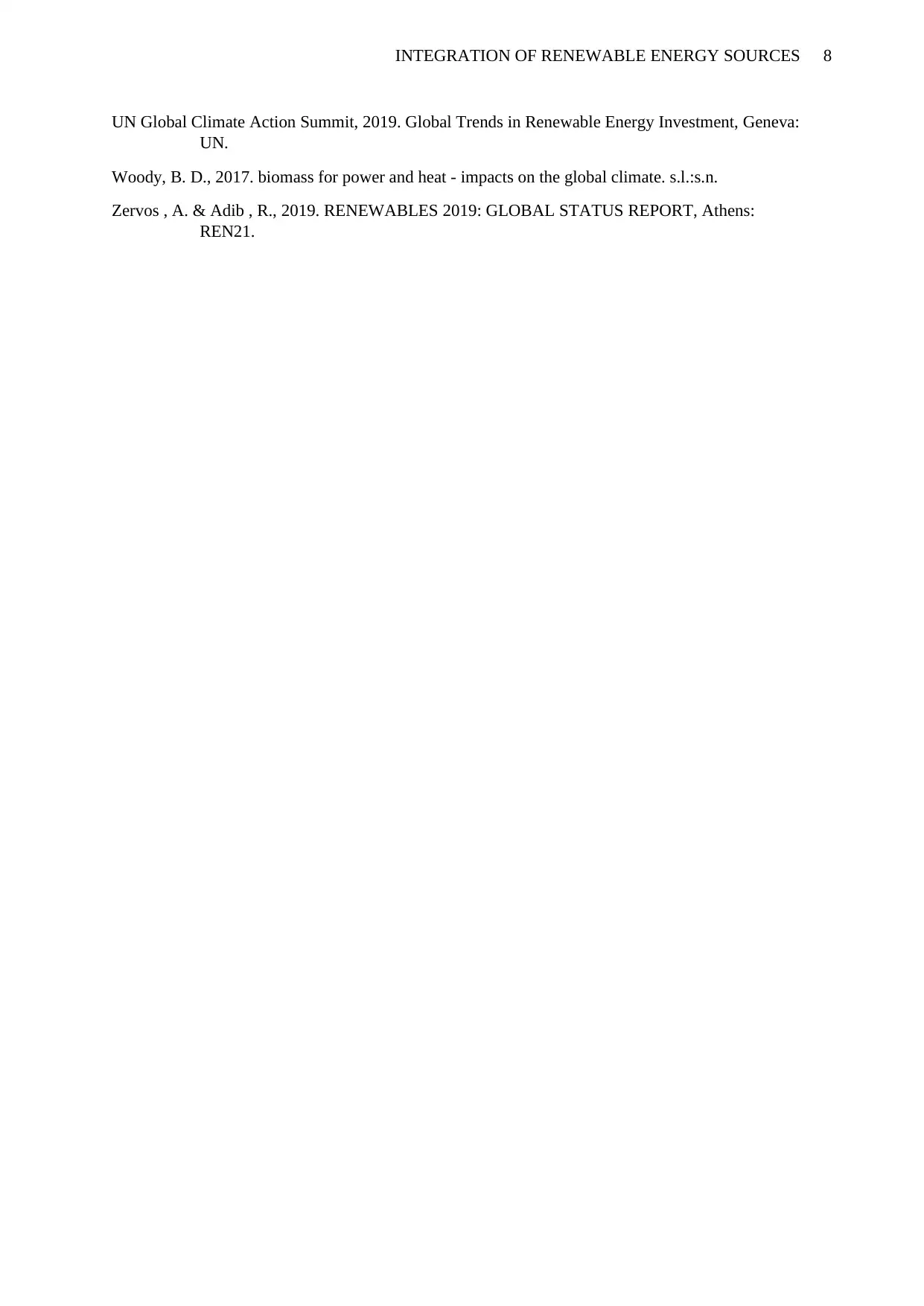
8INTEGRATION OF RENEWABLE ENERGY SOURCES
UN Global Climate Action Summit, 2019. Global Trends in Renewable Energy Investment, Geneva:
UN.
Woody, B. D., 2017. biomass for power and heat - impacts on the global climate. s.l.:s.n.
Zervos , A. & Adib , R., 2019. RENEWABLES 2019: GLOBAL STATUS REPORT, Athens:
REN21.
UN Global Climate Action Summit, 2019. Global Trends in Renewable Energy Investment, Geneva:
UN.
Woody, B. D., 2017. biomass for power and heat - impacts on the global climate. s.l.:s.n.
Zervos , A. & Adib , R., 2019. RENEWABLES 2019: GLOBAL STATUS REPORT, Athens:
REN21.
1 out of 8
Related Documents
Your All-in-One AI-Powered Toolkit for Academic Success.
+13062052269
info@desklib.com
Available 24*7 on WhatsApp / Email
![[object Object]](/_next/static/media/star-bottom.7253800d.svg)
Unlock your academic potential
Copyright © 2020–2025 A2Z Services. All Rights Reserved. Developed and managed by ZUCOL.





